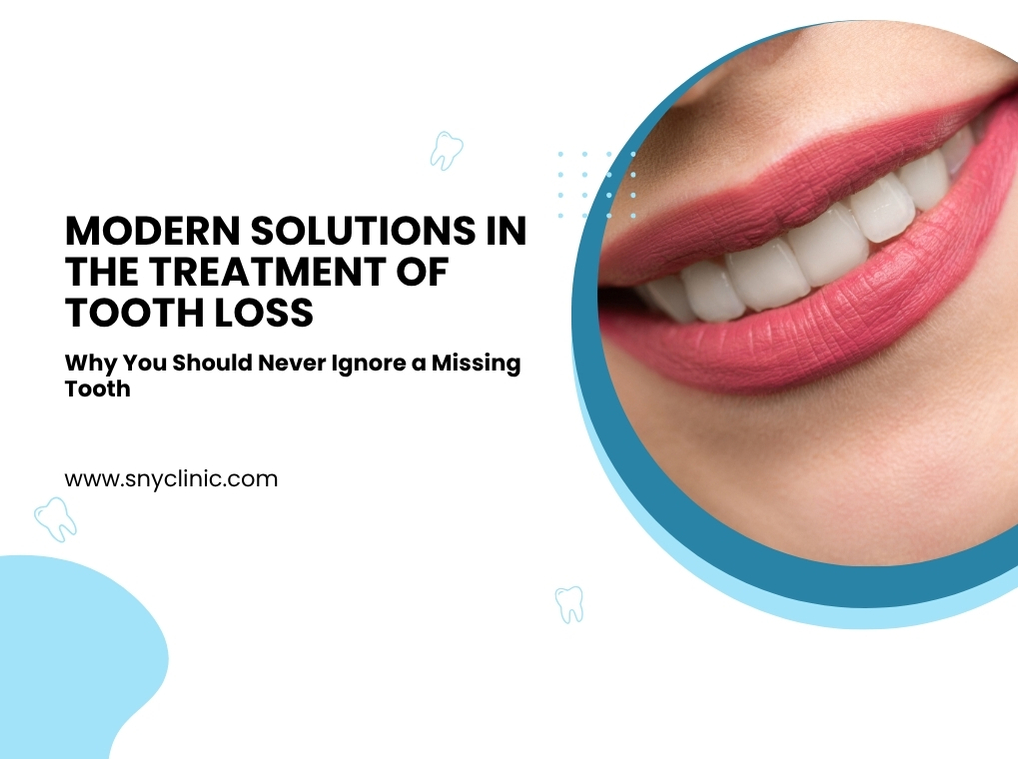
Modern Solutions in the Treatment of Tooth Loss
Modern Solutions in the Treatment of Tooth Loss
Your mouth functions like a delicate mechanism in which all parts work in harmony. Each tooth plays a unique and critical role in this structure. When you lose a tooth, it’s not just about an empty space—it disrupts the entire balance. Over time, surrounding teeth begin to shift into that space, your chewing pattern changes, and a chain of health issues may begin without you even realizing it.
Fortunately, you don’t have to accept this situation. With the advancement of dental technologies, you now have access to personalized solutions that restore this lost balance both functionally and aesthetically. Let’s explore the reasons behind tooth loss and how modern treatment alternatives can help.
Why You Should Never Ignore a Missing Tooth
Tooth loss in the back of the mouth often isn't seen as a visual problem by most people. However, the consequences can be far more serious than expected.
Shifting of Neighboring Teeth:
Nature abhors a vacuum, and your teeth are no exception. Gaps in the mouth lead to adjacent teeth tilting and drifting into that empty space. This misalignment negatively affects your bite and chewing function.
Jawbone Loss (Resorption):
Teeth not only help with chewing but also stimulate the jawbone to keep it healthy. When a tooth is lost, this natural stimulation ceases. The bone in that area begins to weaken and shrink over time. This can make future fixed treatment options like implants more difficult or even require additional surgical procedures.
Chewing and Digestive Issues:
Especially in cases with multiple missing teeth, food cannot be chewed properly, putting extra strain on the digestive system.
Speech Problems:
Missing front teeth can impair the pronunciation of certain sounds, leading to a lisp or unclear speech.
Changes in Facial Aesthetics:
Bone loss and shifting teeth can eventually lead to a sunken facial profile, affecting your appearance.
Modern and Effective Treatment Options for Tooth Loss
Depending on the number and location of missing teeth, the condition of your jawbone, and your budget, there are three main treatment methods that you and your dentist can consider.
1. Dental Implants: The Most Permanent and Natural Solution
One of the most effective and long-lasting solutions in modern dentistry, dental implants are artificial roots made of titanium placed in the jawbone to replace missing teeth. These roots fuse with the bone and act like natural tooth roots. A prosthetic tooth placed on the implant offers excellent aesthetic and functional results.
How It’s Done:
A titanium screw is surgically placed into the jawbone and allowed to fuse with it (osseointegration). Once healed, a porcelain crown is placed on top.
Advantages:
- Extremely durable and provides a natural feel when chewing.
- Can be placed without affecting adjacent healthy teeth, preserving overall tooth structure.
- Prevents bone loss by stimulating the jawbone.
- Can last a lifetime with proper care.
Who Is It Suitable For?
It is ideal for anyone in good general health with sufficient jawbone density.
2. Dental Bridges: A Quick and Aesthetic Alternative
Bridge treatment involves filling the gap left by a missing tooth by anchoring a prosthetic tooth to the healthy teeth on either side. This method provides a satisfactory appearance and is a quick and practical option.
How It’s Done:
The adjacent teeth (abutments) are slightly reduced in size. A bridge consisting of three or more connected crowns is created in a dental lab and cemented onto these teeth. The middle crown fills the gap.
Advantages:
- Faster than implant treatment.
- No surgical procedure is needed.
- Fixed in place, offering ease of use and aesthetics.
Disadvantages:
- Requires the reduction of healthy adjacent teeth.
- Does not prevent underlying bone loss.
3. Removable Dentures (Take-Out Solutions)
A practical solution often used in cases of multiple tooth loss or when implants/bridges are not viable.
How It’s Done:
These dentures consist of artificial teeth placed on an acrylic or metal framework. They are secured in the mouth using special attachments or metal clasps that grip existing teeth.
Advantages:
- More affordable than other treatment options.
- Easy to apply and requires no surgery.
Disadvantages:
- Must be removed and cleaned after every meal.
- May cause difficulties in speaking or tasting initially.
- Less comfortable and stable than fixed prosthetics.
Which Treatment Option Is Right for You?
This answer varies for each individual. Here are the key factors that influence the decision:
- Number of Missing Teeth: Implants are often the first choice for single-tooth replacements.
- Bone Health: If the jawbone has enough volume and density, implants may be preferred. Otherwise, bridges or removable dentures may be more appropriate.
- Budget: Removable dentures are the most economical, while implants are costlier initially.
- Expectations: If longevity and natural feel are priorities, implants are ideal. If speed is more important, bridges may be preferred.
Don’t Delay—Reclaim Your Smile!
Tooth loss is a health problem that should not be postponed, as it can lead to more complex and costly issues over time. Beyond aesthetic concerns, filling that gap with a professional solution is one of the most important steps you can take for your overall health.
Consult a dentist to determine the most suitable treatment for you and restore your smile with confidence. Remember, a healthy smile is one of the most valuable investments you can make in yourself.




